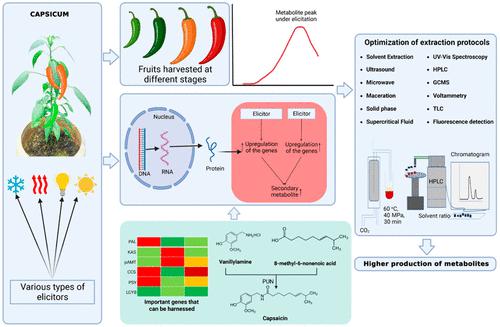当前位置:
X-MOL 学术
›
J. Agric. Food Chem.
›
论文详情
Our official English website, www.x-mol.net, welcomes your
feedback! (Note: you will need to create a separate account there.)
Genetic Regulation, Environmental Cues, and Extraction Methods for Higher Yield of Secondary Metabolites in Capsicum
Journal of Agricultural and Food Chemistry ( IF 5.7 ) Pub Date : 2023-06-08 , DOI: 10.1021/acs.jafc.3c01901 Khushbu Islam 1 , Abdul Rawoof 1 , Ajay Kumar 2 , John Momo 1 , Ilyas Ahmed 1 , Meenakshi Dubey 3 , Nirala Ramchiary 1
Journal of Agricultural and Food Chemistry ( IF 5.7 ) Pub Date : 2023-06-08 , DOI: 10.1021/acs.jafc.3c01901 Khushbu Islam 1 , Abdul Rawoof 1 , Ajay Kumar 2 , John Momo 1 , Ilyas Ahmed 1 , Meenakshi Dubey 3 , Nirala Ramchiary 1
Affiliation

|
Capsicum (chili pepper) is a widely popular and highly consumed fruit crop with beneficial secondary metabolites such as capsaicinoids, carotenoids, flavonoids, and polyphenols, among others. Interestingly, the secondary metabolite profile is a dynamic function of biosynthetic enzymes, regulatory transcription factors, developmental stage, abiotic and biotic environment, and extraction methods. We propose active manipulable genetic, environmental, and extraction controls for the modulation of quality and quantity of desired secondary metabolites in Capsicum species. Specific biosynthetic genes such as Pun (AT3) and AMT in the capsaicinoids pathway and PSY, LCY, and CCS in the carotenoid pathway can be genetically engineered for enhanced production of capsaicinoids and carotenoids, respectively. Generally, secondary metabolites increase with the ripening of the fruit; however, transcriptional regulators such as MYB, bHLH, and ERF control the extent of accumulation in specific tissues. The precise tuning of biotic and abiotic factors such as light, temperature, and chemical elicitors can maximize the accumulation and retention of secondary metabolites in pre- and postharvest settings. Finally, optimized extraction methods such as ultrasonication and supercritical fluid method can lead to a higher yield of secondary metabolites. Together, the integrated understanding of the genetic regulation of biosynthesis, elicitation treatments, and optimization of extraction methods can maximize the industrial production of secondary metabolites in Capsicum.
中文翻译:

提高辣椒次生代谢产物产量的遗传调控、环境线索和提取方法
辣椒是一种广受欢迎且消费量大的水果作物,含有有益的次生代谢产物,如辣椒素、类胡萝卜素、类黄酮和多酚等。有趣的是,次级代谢产物谱是生物合成酶、调节转录因子、发育阶段、非生物和生物环境以及提取方法的动态函数。我们提出了主动可操作的遗传、环境和提取控制来调节辣椒物种中所需次生代谢物的质量和数量。辣椒素途径中的特定生物合成基因,如Pun ( AT3 ) 和AMT以及PSY、LCY和类胡萝卜素途径中的CCS可以通过基因工程分别提高类辣椒素和类胡萝卜素的产量。一般而言,次生代谢产物随着果实的成熟而增加;然而,转录调节因子如MYB、bHLH和ERF控制特定组织中的积累程度。生物和非生物因素(例如光、温度和化学诱导子)的精确调节可以最大限度地提高采前和采后环境中次生代谢物的积累和保留。最后,优化的提取方法(例如超声法和超临界流体法)可以提高次级代谢产物的产率。总之,对生物合成的遗传调控、诱导处理和提取方法优化的综合理解可以最大限度地提高辣椒次生代谢物的工业生产。
更新日期:2023-06-08
中文翻译:

提高辣椒次生代谢产物产量的遗传调控、环境线索和提取方法
辣椒是一种广受欢迎且消费量大的水果作物,含有有益的次生代谢产物,如辣椒素、类胡萝卜素、类黄酮和多酚等。有趣的是,次级代谢产物谱是生物合成酶、调节转录因子、发育阶段、非生物和生物环境以及提取方法的动态函数。我们提出了主动可操作的遗传、环境和提取控制来调节辣椒物种中所需次生代谢物的质量和数量。辣椒素途径中的特定生物合成基因,如Pun ( AT3 ) 和AMT以及PSY、LCY和类胡萝卜素途径中的CCS可以通过基因工程分别提高类辣椒素和类胡萝卜素的产量。一般而言,次生代谢产物随着果实的成熟而增加;然而,转录调节因子如MYB、bHLH和ERF控制特定组织中的积累程度。生物和非生物因素(例如光、温度和化学诱导子)的精确调节可以最大限度地提高采前和采后环境中次生代谢物的积累和保留。最后,优化的提取方法(例如超声法和超临界流体法)可以提高次级代谢产物的产率。总之,对生物合成的遗传调控、诱导处理和提取方法优化的综合理解可以最大限度地提高辣椒次生代谢物的工业生产。











































 京公网安备 11010802027423号
京公网安备 11010802027423号